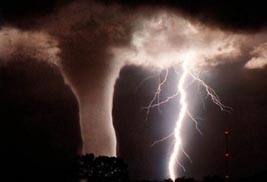Featured Article
Kent State University Library to be Open 24 Hours a Day, Five Days a Week
Supporting student success and responding to requests for extended hours, the Kent State University Library will be open 24 hours, five days a week following spring break.
read moreSevere Weather Safety Week is March 20 to 26; Expect Emergency Alert Notification Tests
Posted March 21, 2011More than 178 tornadoes have been recorded in Ohio since 2000. Typically at peak season, beginning in April and extending through July, tornadoes are among nature's deadliest storms, capable of enormous destruction and wind speeds in excess of 200 to 300 miles per hour.

Tornadoes are among nature's deadliest storms.
Tornadoes generally originate as particularly violent thunderstorms. While they are most clearly identified by rotating, funnel-shaped air columns that stretch from the storm clouds to the ground, heavy rain or debris sometimes prevent the funnel from being clearly visible. Tornadoes can develop very quickly and, consequently, offer little to no warning of their approach.
In order to educate the public about emergency warning procedures and appropriate safety precautions, the week of March 20 - 27 has been designated as Severe Weather Safety Week. Additionally, Wednesday, March 23, has been selected as Tornado Awareness Day. On this day, the tornado warning signals throughout the entire state of Ohio will be activated at 9:50 a.m. No action is required during Wednesday's test.
Kent State, the city of Kent and Franklin Township have an emergency outdoor warning system that provides residents with immediate notification of impending emergencies, such as tornadoes. When emergency conditions exist, the city of Kent, as well as Kent State, will activate an audible outdoor siren and during an actual emergency, its signal will sound for at least nine minutes. When the alarm is activated, everyone should go immediately to the nearest tornado shelter.
This emergency outdoor warning system is tested twice each month, on the first Wednesday at 11 a.m. and on the third Wednesday at 6:30 p.m. Tests last only three minutes. It is not necessary to seek shelter during tests unless the siren continues past three minutes, at which time it should be assumed that a threatening situation exists.
Each university building has a key area or areas that have been identified as tornado shelters. As a general rule, shelter from tornadoes is best achieved in the lowest level of a building and away from windows and exterior walls, but not under wide, expansion-type roofs.
When an emergency signal has been activated, everyone should seek shelter and remain there until at least 20 minutes after the last siren has ceased. There is no " all clear" signal. After 20 minutes have passed without a warning from the siren, normal activities can resume.
Please do not call Police Services for verification of the emergency indicated by the siren. Instead, tune your radio to WPND-AM (1620), WNIR-FM (100.1) or WKSU-FM (89.7) for an update of weather conditions and the status of the emergency situation. These radio stations will provide information regarding the type and location of the emergency, instructions for what to do and where to go, as well as confirmation when danger has passed.
In addition to the warning siren system, each building on campus has been equipped with a Mass Notification System. When activated, the system will sound an alert tone, followed by information and instructions concerning the warning. Additional instructions and updates of the current emergency situation may be broadcast from this system. This system may be activated during situations that are not weather-related and may be independent of the emergency outdoor warning system.
For more details about these procedures, contact Matt Radigan, Department of Public Safety at 330-672-3111 or via e-mail at mradigan@kent.edu. Additional information about tornado safety also can be found in the Department of Public Safety's Emergency Guide.
For more information about Severe Weather Safety Week, go to http://www.weathersafety.ohio.gov.